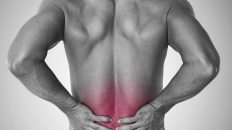Pain in the muscles and joints of the hands and shoulders is a relatively common condition that can be caused by strain, injury and various types of illness. If the pain does not go away, it is important to contact your doctor and have all the necessary examinations done. On this basis, it will be possible to implement treatment, which in many cases includes physiotherapy. One of its methods is vibrotherapy. We explain how it works and in which hand ailments it can help.
Shoulder pain causes
Pain in the shoulder usually involves the muscles, tendons, bones and surrounding structures. It can be short-term or chronic. Depending on the cause, it can occur at different times, be associated with movement or worsen at rest. It is most commonly associated with damage to the tissues surrounding the joint, osteoarthritis, and can also be the result of inflammatory diseases, as well as health problems unrelated to the musculoskeletal system. Left shoulder pain may suggest an early heart attack or cardiac problems. The most common causes of shoulder pain are trauma, overloading, repetitive microtrauma arising from daily activities or sports.
Shoulder and arm pain
Shoulder pain is a very complex problem with various causes. The most common causes of shoulder pain are degeneration of the joint, damage to the rotator cone, subacromial bursitis, subacromial tunnel syndrome (subacromial compression syndrome),and frozen shoulder. Sometimes the cause is heavy lifting and the use of a local anaesthetic and cold compresses is sufficient.
All of these conditions need to be fully diagnosed and properly managed. Non-steroidal anti-inflammatory drugs, painkillers and physical therapy are most commonly used to treat them. Often the condition and severity of the condition necessitates surgical treatment. Shoulder pain is often associated with restricted movement and reduced comfort in daily functioning. Chronic pain can also increase stress levels and cause headaches. Treatment is very often time-consuming and requires close cooperation between the patient and the treating physician. The role of physical therapy, both by specialists and at home, should not be underestimated here.
Rotator cone injury
This type of rotator-ring injury most commonly occurs in people over 40 years of age. Rotator cone damage is often associated with subacromial tightness (subacromial tunnel syndrome). The rotator cone is the tendon of the four muscles that stabilise the shoulder joint. As a result of degenerative changes or damage, the tendon is torn or ruptures completely. Shoulder pain increases slowly and occurs when lifting the arm upwards. Shoulder pain also prevents sleep on the affected side. There is a limitation of function of the upper limb.
Subacromial tunnel syndrome
The diagnosis in this case is based on a medical (GP) history, clinical examination and imaging studies. Damage to the rotator cuff has two main causes, the age of the patient when it is one of the symptoms of ageing, or trauma resulting from an accident or injury during sports. Only injuries resulting from trauma and mechanical injuries are treated surgically. The doctor may introduce pharmacological treatment, stabilisation of the shoulder and humerus.
Subacromial compartment syndrome
When, as a result of inflammation of the subacromial space or the formation of bony outgrowths, the natural smooth sliding movement of the humerus under the shoulder process is blocked, subacromial compartment syndrome occurs. This results in acute arm pain/shoulder pain, which increases with movement. The causes of this condition can vary, prolonged overhead hand movements can damage the rotator cuff, which narrows the subacromial space. A history of inflammation of the subacromial bursa also contributes to the development of subarbar tightness syndrome. Factors may include degeneration of the supraspinatus muscle and the previously mentioned rotator cuff injury. Shoulder pain may be felt mainly when performing activities with the hands raised at the shoulder, as well as when sleeping on the affected shoulder. Rest, reduction of shoulder pain and swelling with appropriate medication and restriction of physical activity are most commonly recommended for subacromial tightness syndrome. Exercise-based physiotherapy is also the basis of conservative treatment. Exercise therapy should focus on strengthening the rotator cone and the muscles that stabilise the scapula. In cases where conservative treatment does not have the desired effect, surgical treatment of the shoulder may be necessary.
Frozen shoulder
Frozen shoulder, or inflammation of the joint capsule, can occur as a result of damage to the rotator cone or diseases not directly related to the shoulder joint, such as thyroid disease, diabetes or heart attack. The condition is characterised by a severe restriction of mobility in the shoulder joint, accompanied by increasing pain in the shoulder. The discomfort makes daily life very difficult. The shoulder pain also prevents the patient from sleeping on the affected shoulder. Most often, the discomfort gradually subsides as treatment is carried out. Depending on the degree of restriction of movement, this can take from few to several months. The mainstay of treatment is appropriate exercise and physical therapy, sometimes steroid injections are required, as well as the use of NSAIDs and other medications, and sometimes surgical intervention is necessary. However, incomplete recovery is common, with the ailments returning in the opposite shoulder.
Osteoarthritis of the shoulder joint
As a consequence of inflammation, severe mechanical overload or trauma to the shoulder joint, there is very often destruction of the articular cartilage and other structures around it. This is the main cause resulting in shoulder pain in people over 60 years of age. Often, shoulder pain is also associated with restricted movement and the presence of pressure soreness. Degenerative changes can occur after trauma, overloading, in people with joint instability or in people with chronic illnesses such as rheumatoid arthritis (RA). In addition to pain relief and rehabilitation, in some cases surgical treatment should be considered. For osteoarthritis of the shoulder joint, prevention and adequate prevention of inflammation and overload are very important. Physical activity to improve the shoulder joints, good work hygiene and healthy habits can reduce the likelihood of joint surface degeneration.
Damage to the tendon of the long head of the biceps
Damage to the long head of the biceps muscle can also be a cause of shoulder and arm pain. This is usually caused by trauma. In the case of long-term inflammation, a steroid injection is used to “calm the inflammation”. Rupture of the tendon of the long head of the biceps very rarely requires surgical treatment. Most often, conservative treatment and appropriately selected physical therapy are used. This form of treatment gives the best results.
Shoulder pain at night
Shoulder joint pain occurring at night very often affects one shoulder. It may be related to inflammation of the periarticular structures. If the pain intensifies after lying on the affected shoulder joint, it may be indicative of rotator cone damage or subacromial compression syndrome. These are two conditions that manifest themselves as acute, excruciating pain. Also osteoarthritis of the shoulder joint, rheumatoid arthritis or psoriatic arthritis can give symptoms of nocturnal shoulder pain. In this case, analgesics and anti-inflammatory medications, as well as appropriately implemented physical therapy to relieve the painful strains of my discomfort, appear to be helpful. A form of physical therapy helpful for shoulder pain is vibrotherapy.
Shoulder pain at rest
Shoulder pain at rest occurs in the course of many diseases, whether rheumatic, degenerative or as a result of mechanical trauma. Shoulder arthritis can be a symptom of developing rheumatoid arthritis (RA) or gout, psoriatic arthritis also often presents with shoulder pain. The factors causing both short-term and chronic shoulder pain are numerous. Therefore, it is important to correctly diagnose its causes. Most often, imaging methods are used during diagnosis, i.e. x-rays, MRI or CT scans. Certainly, pain in the shoulder area should not be underestimated as untreated pain may lead to permanent impairment of movement in the joint.
Pain in the hands and arms due to overloading or deficiencies
Among one of the causes of pain felt in the hands and arms are post-exercise pains. These occur after overloading the muscles and joints with too much training or work. This is particularly the case when a series of repetitive movements are performed using the same muscles. Examples of sports that can cause this kind of pain are tennis or boxing. It is then important to ensure proper recovery, rest and sleep.
Shoulders and arms often ache for completely opposite reasons – in situations where we are forced to stay in the same position for a long time, e.g. in front of a computer, which causes excessive muscle tension. This type of pain can be recognised above all by the fact that the sore area is slightly harder, the pain is constant and increases when touched.
Various cramps and vitamin deficiencies, especially of magnesium or vitamin B6, can also be a cause of pain in this area.
Pain caused by degenerative diseases
In adults over 40 years of age, osteoarthritis can be the cause of pain in the hands and arms. Osteoarthritis pain is diagnosed when the patient notices stiffness in the joint and limited mobility. Often there is also deformity of the joint or a crackling sensation during movement. It is worth bearing in mind that pain in the hand or arm can also be caused by changes in the spine – it does not necessarily have to be related to damage in the area where the pain is felt.
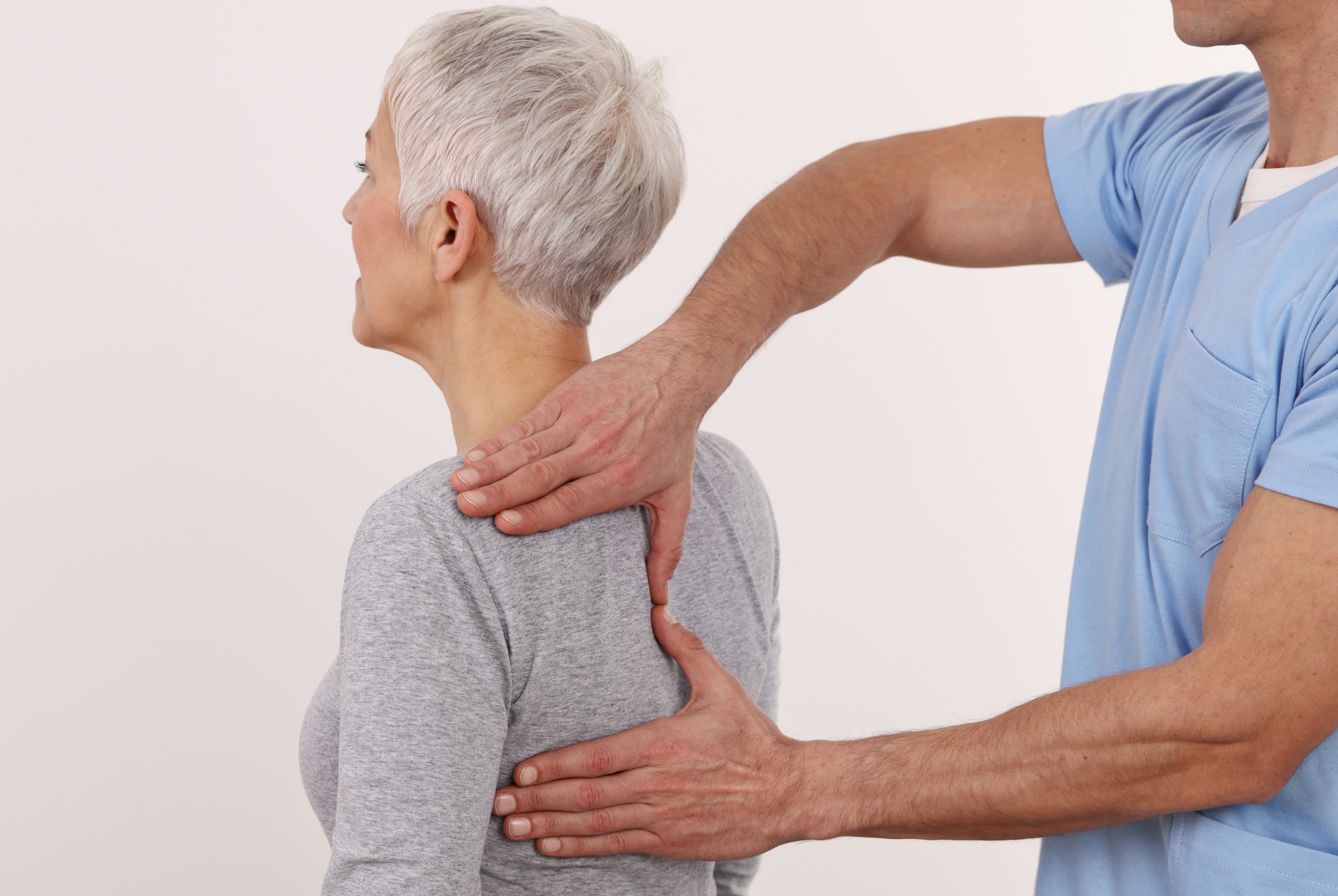
Degenerative diseases occur spontaneously or after injuries and illnesses, including autoimmune diseases, which now affect an increasing proportion of the population. The risk of osteoarthritis is increased by the presence of factors such as obesity, frequent carrying of heavy objects or prolonged standing in one position.
Pain of an inflammatory nature in the muscles or joints of the hands and arms
Pain of an inflammatory nature is described as dull and extremely unpleasant. It co-occurs with increased stiffness, especially after resting, slight swelling, redness or a warm sensation around the sore area.
It is associated with damage to the soft tissues and joints in the musculoskeletal system. As the hands and arms are constantly used during all basic activities, they are slightly more exposed to it than other structures. A variety of diseases can be at the root of inflammatory pain, so it requires extensive diagnosis and effective treatment.
Neurological pain in the hands and arms – possible causes
Hand and arm pain occurs due to a malfunction of the nervous system or in connection with neurological diseases. Examples of such diseases include multiple sclerosis, Parkinson’s disease or tumours of the central nervous system. Pain in itself is also a separate disease entity that is subject to treatment.
Neurological pain can occur as a result of neuropathy, which is damage or inflammation within the peripheral nerves. This in turn causes sensory and motor disturbances, as well as tingling, burning, numbness and other discomforts. Neuropathies occur in the course of diseases such as multiple sclerosis, Lyme disease, hemiplegia or cancer. In the case of neuropathies, the pain in the hand may be localised in the outer part of the hand or involve the fingers.
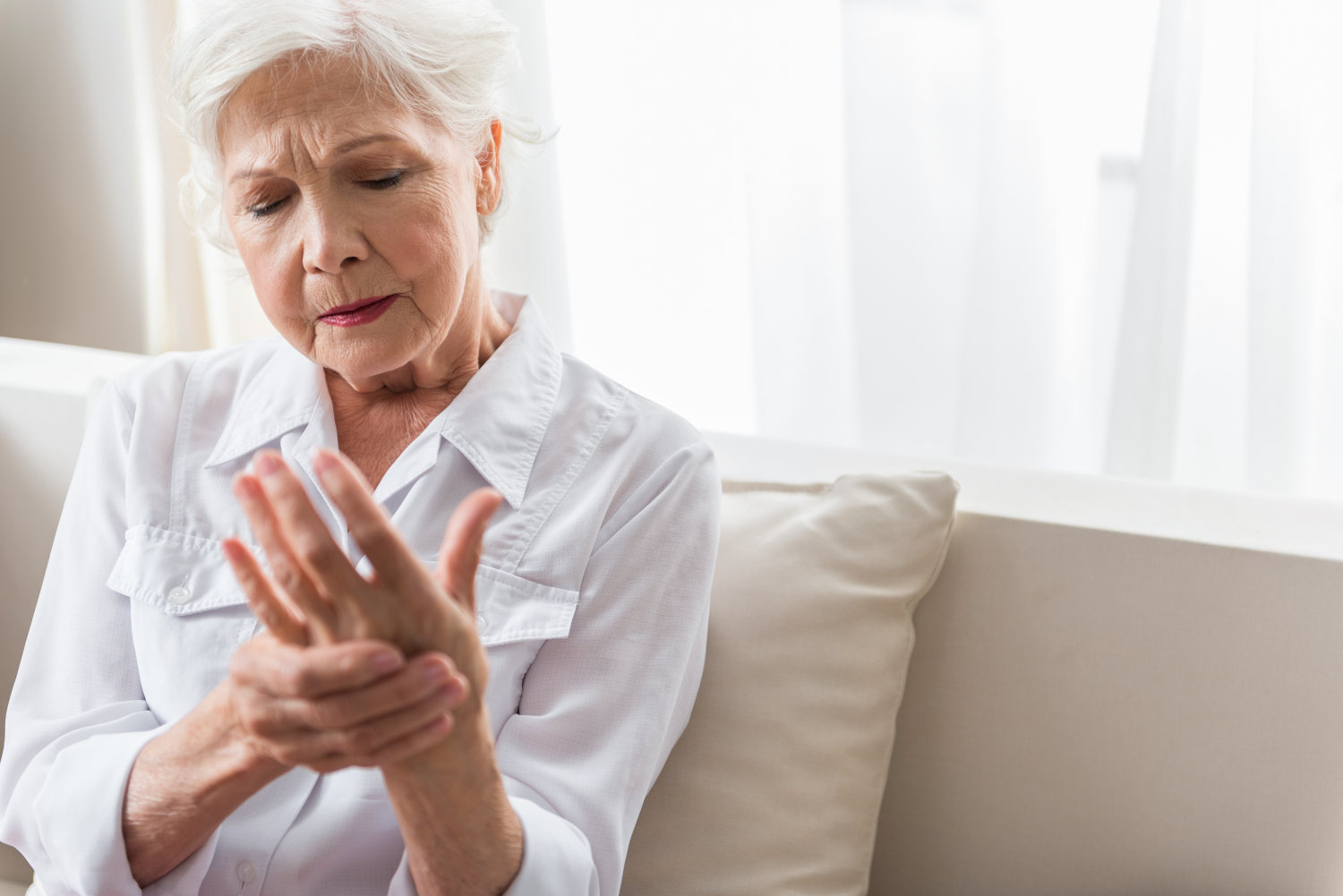
Post-traumatic pain in the shoulder joint and hands
The shoulder joint is one of the joints that is most frequently injured (right after lower limb injuries). Injuries to the shoulder joint do not only affect athletes. Injury can occur during everyday activities or unforeseen accidents, e.g. when lifting the arm up. This joint is particularly prone to injury mainly due to its rather complex structure and high mobility. It often radiates and pain is also felt in the elbow joint.
The healing period for an injury to the shoulder, arm or hand can take up to a year. Restricting physical activity, using physiotherapy, including vibrotherapy, or implementing pharmacology is helpful during this time. For the most complicated injuries, surgical treatment may be necessary. The use of painkillers, which only relieve but do not repair the shoulder joint, is not recommended.
Shoulder pain – how to treat
Shoulder pain and arm pain is most often treated by conservative management. Restriction of movement, reduction of strain and appropriately selected physical therapy. Vibrotherapy is increasingly being used to treat shoulder pain. In specific cases, analgesics and anti-inflammatory drugs, i.e. non-steroidal anti-inflammatory drugs and steroids, are used to reduce pain and inflammation. In extreme cases, surgery may be required to restore function to the shoulder joint. Read what you can do if you are bothered by chronic pain in your shoulder or any other part of your body.
The analgesic effect of vibrotherapy
The effectiveness of vibrotherapy in the treatment of pain is due to its multi-level action. The vibrations emitted by vibrotherapy devices act on both superficial and deeply located pain receptors. In addition to this, this type of therapy improves blood and lymph flow, which promotes tissue nourishment and further increases the patient’s pain threshold.
If the pain is caused by excessive muscle tension, vibrotherapy can effectively reduce it and also help strengthen the muscles, which is especially important in the case of pain caused by muscles that are too weak to support normal posture. When applied to the back, vibrotherapy assists the paraspinal muscles and deep muscles that are responsible for maintaining posture and organs in the correct position.
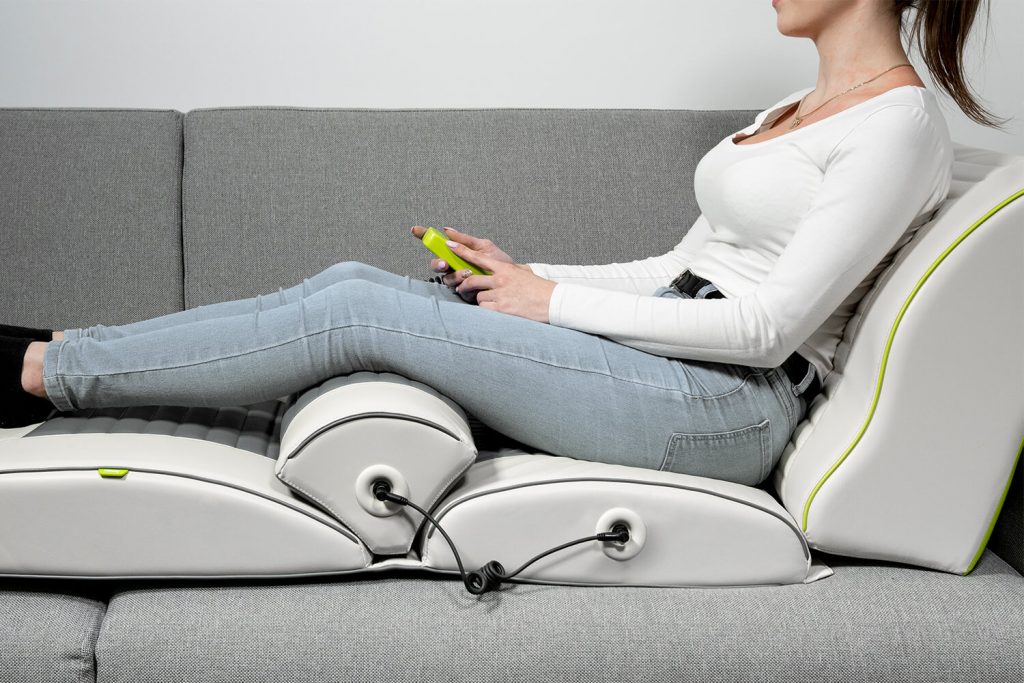
Vibrotherapy has no risk of side effects, but guarantees long-term results with regular therapy. The improvement is usually already noticeable after the first treatment.
For whom is vibrotherapy a suitable solution?
Vibrotherapy is excellent for treating pain and discomfort of various aetiologies. In addition, it is a great preparation for physical, corrective and compensatory exercises, as well as training performed with a physiotherapist.
It is very suitable for seniors, overweight people and those with degenerative diseases that cause pain. Vibrotherapy can also assist people who are recovering from various accidents and injuries.
Hands module working in conjunction with the Back module
As vibrotherapy has begun to gain popularity, devices have been introduced to the market that allow treatments to be carried out at home. The Vitberg brand, well known to anyone previously familiar with the principles of vibrotherapy, has developed the Hands Module, working in conjunction with the Back Module. These work in conjunction with the Vitberg RS base device.
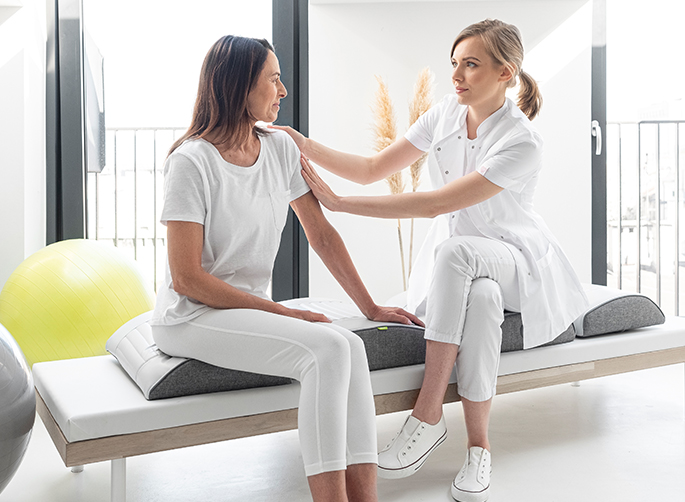
These modules can freely interact with the entire spine, arms, shoulders and neck, improving peripheral circulation, the efficiency of the shoulder girdle and relieving pain in these areas. They can also successfully help with the symptoms that accompany pain, i.e. numbness, a feeling of stiffness or excessive tension. They can also be used effectively in rehabilitation and post-workout recovery. The duration of a single treatment for the back and hands using the modules is 30 minutes.
References:
Dobrogowski J., Zajączkowska R., Dutka J., Wordliczek J. Patofizjologia i klasyfikacja bólu. Pol. Przegl. Neurol 2011;7(1):20-30.
Domżał T. Ból przewlekły – problemy kliniczne i terapeutyczne. Pol. Przegl. Neurol 2008;4(1):1-8.
Szczudlik A., Jan Dobrogowski J., Wordliczek J., Stępień A. i in. Rozpoznanie i leczenie bólu neuropatycznego: przegląd piśmiennictwa i zalecenia Polskiego Towarzystwa Badania Bólu i Towarzystwa Neurologicznego – część druga. Ból 2014, Tom 15, Nr 3, s. 8-21.
Stambolieva K., Petrova D., Irikeva M., Positive effects of plantar vibration training for the treatment of diabetic peripheral neuropathy: A pilot study. Somatosensory & Motor Research 2017.
Adriano P. Simão, Núbia C. Avelar, Rosalina Tossige-Gomes, Camila D. Neves, Vanessa A. Mendonça Functional Performance and Inflammatory Cytokines After Squat Exercises and Whole-Body Vibration in Elderly Individuals With Knee Osteoarthritis. Arch Phys Med Rehabil Vol 93, October 2012



